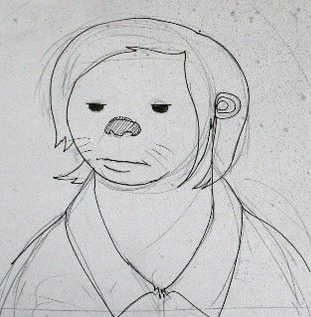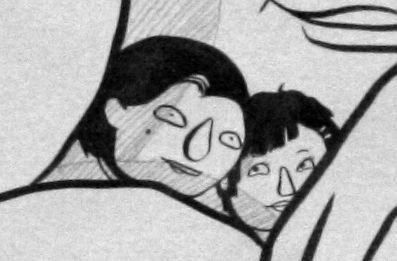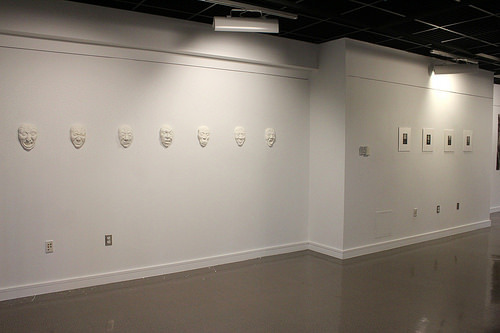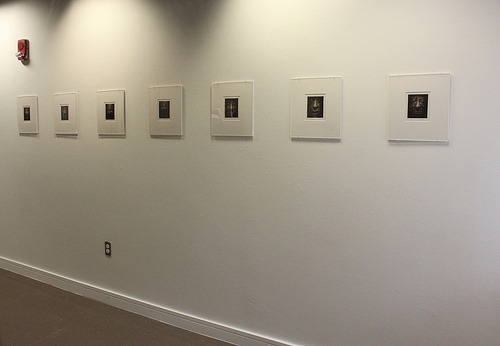Clara Lieu's Blog, page 28
May 15, 2015
Everything has led up to this
For many of my freshman students at RISD, choosing a major can be stressful. Even after they’ve officially declared their major, many students still have doubts about their choice at the end of the year. More and more, it’s become clear to me that no matter what major they choose, that experience will ultimately be valuable.
I was an Illustration major, and while I did take a diverse range of courses at RISD, I eventually focused my last two years on figurative oil painting. After graduation, I continued oil painting for another four years. It has been nine years since I picked up a brush to oil paint, and to this day I have only completed one professional illustration job. Does that mean all of those years I spent learning illustration and oil painting were wasted? Not at all; one thing I’ve learned over the past few years is that every experience I’ve had has made a contribution to my artistic growth. Even circumstances I resented or was skeptical about have enhanced my progress. Over time, I’ve amassed a wealth of experiences which allows for my skills to come and go in response to what I’m working on at the time.
The video series I’m working on right now is proof of that. I’m basically trying to write down literally everything I know. Every course I’ve taught, every artwork I’ve made, every exhibition I’ve organized, every article I’ve written, etc. will inform this project. This is an enormous undertaking, and every time I sit down to write, I’m overwhelmed by how much I have to share. The project is a culmination of everything I’ve learned in my entire life.


May 9, 2015
RISD Freshman Drawing, Spring 2015
This week has been packed with final crits in my Freshman Drawing classes at RISD. I’m always amazed that as much as things have change, some things remain fundamentally the same. Every May, I see the same emotions that I experienced as a freshman in my students. My students are deeply immersed in their experience right now, so it’s impossible for them to get any perspective on their freshman year because it’s too close to them. I, on the other hand, have had 17 years to ruminate on my freshman year at RISD, and it got me thinking about my answer to a question a student asked me during a Q&A on the last day of class: “What do you want us to take away from our freshman year?”
My answer to that question is that even though I demand that my students invest tremendous time and effort into creating and critiquing their artwork freshman year, ultimately, it is not the artwork that is most significant. In fact, I stress to my students that within a year or two, the final projects they worked on this week won’t matter to them. Some might see that as a negative outlook, but I see it as being positive: if that final project isn’t important to you later on, it means that you’ve moved on to greater things.
I describe to my students where the artwork from my freshman year went: some of it I sold at open studios events or at a yard sale, some of it went into the recycle bin, some of it to the garbage, there is one pile of newsprint drawings packed into a portfolio sitting in the back of a closet in my house, and there are two plaster sculptures that are sitting on my fireplace mantle.
So if the artwork ultimately doesn’t matter, what does? It’s the thinking strategies, the work ethic, and the mindset that you can carry with you for the rest of your life. My greatest hope for my students is that after finishing freshman year, they feel empowered and completely capable of dealing with anything that gets thrown at them. After my freshman year, I felt like I had gone to hell and back. As difficult as freshman year could be at times, nothing intimidated me anymore. I knew that no matter how challenging the circumstance was, I would find a way to handle it. Today, I know that I will never miss a deadline, and if there is any doubt in my mind that I might not meet a deadline, I simply say no. Freshman year at RISD stretched me to extremes that I didn’t even know existed, and I developed an acute understanding of just how far I could push myself. These are the qualities that I use every day.
You can view student portfolios with artwork from my Thursday and Friday classes on my Flickr page.


April 28, 2015
What gets thrown out
I read an article today written by Mad Men creator , detailing the obstacles he went through to get to where he is today. I’ll admit that most of the time I find motivational articles for struggling artists annoying. Many articles either 1) don’t acknowledge the blood, sweat and tears it took to get there, 2) mention that an artist had a priceless connection which ignited their careers or 3) are about an artist who won a prestigious award which brought them incredible success in their 20’s.
The truth of the matter is that while amazing success does happen for a few artists, for the vast majority, it’s a tedious, daily grind. Consequently, many artists develop unrealistic expectations about what they should have accomplished by now. This can be extremely discouraging, and it’s too easy to become bitter and resentful. In the article, Weiner talks about feeling this way:
“I got very bitter, seeing people I didn’t think deserved it succeed. It was a dark time. Show business looked so impenetrable that I eventually stopped writing.”
Even though I’m not a Hollywood writer, I saw myself in Weiner’s anecdotes. (minus the part about having a hit TV show)
“While being battered always hurts, an important survival mechanism I’ve acquired over the years is to both thrive on rejection and hold on to compliments. Rejection enrages me, but that “I’ll show you!” feeling is an extremely powerful motivator.”
The article was another reminder that most of what I do won’t make the final cut. This can be frustrating: you invest tons of time, only to end up using just 10% of what you made. I’ve experienced this in everything I do, from creating artwork, writing materials for courses I teach, and my advice column.
“If you don’t get to see the notes, the rewrites, and the steps, it’s easy to look at a finished product and be under the illusion that it just came pouring out of someone’s head like that.”
In my freshman drawing class at RISD, I require my students to create at least 6 thumbnail sketches in advance of starting the final drawing for their homework assignments. A common issue is that many students pass in 6 thumbnail sketches that all look the same. I compare it to going to a buffet dinner that has 20 plates of the same chicken dish. Diversity within a set of thumbnail sketches is critical; if the 6 sketches look the same, it means that 5 of those sketches are useless.
Even when you do have a strong, diverse set of thumbnail sketches, ultimately you’ll only go with one, while the other 5 get thrown out. As a means of comparison, I asked the students how many rounds of sketches they thought it must have taken to arrive at the final iPhone design. One student simply said “most of the ideas were thrown out.”
Be willing to part with those sketches, you might be surprised at what you could gain.


April 22, 2015
Survey Results
I was pleasantly surprised that many of you filled out my online survey for my video series project. Thanks to all of you who participated! I found the results fascinating, many of the responses reinforced what I had concluded on my own which is significant; it’s hard for me to step outside of my own head and see the project through the eyes of my target audience. Many people suggested some small details that I hadn’t thought of. For example, someone from Europe said that it would be good to have the option to watch the videos with subtitles so they could understand better.
Across the board, people emphasized how important it is to have professional videos with excellent audio, clean editing, a wide range of camera views, and HD quality. Pacing was another issue that people felt strongly about. Most of the tutorials people had seen were achingly slow and boring, so much so that they would just skip through the video instead of watching from start to finish. Some videos were so fast to the point that important steps in the process were left out. A few months back, I was talking to a friend who seemed to think that as long as the content was there, the technical execution of the video was not as critical. Apparently, that theory isn’t true according to the survey results. One person commented: “People say looks aren’t everything….they are dead wrong. Looks are everything.”
People seemed to respond enthusiastically to the idea of making the project as interactive as possible. I like the idea of interacting with viewers because it’s a way to make the project more similar to what actually happens in my classroom. Even though I do lectures and demonstrations where it’s just me talking, the vast majority of my time in the classroom is devoted to responding to questions from students. If there’s no dialogue between myself and the viewers in this project, then I’ll just talking at my audience, not with them. This project needs to be constantly reacting and growing with the audience.
Another major concern was having concrete supply lists. In addition to being explicit about what to buy for each tutorial, people really wanted to have several options for what they could buy. This makes sense, not all of us can afford to spend $50 on a 1.25 oz. tube of oil paint, and art supplies can really add up. Having been a poor art student myself, it’s really useful to know when you can cut corners. There are some items where I do think you absolutely must have a specific supply, but there are also times when it’s okay to get a super cheap item that will get the job done just as well as the more expensive option.
Another mistake many tutorials seem to make as well is the assumption that people have previous experience, and therefore they leave out fundamental concepts in the video. One person said they wanted to see “basic, basic technique.” Another commented that they found skipping over fundamentals very intimidating, because they felt that the video was only for people who are at a more advanced level.
Finally, this was one of my favorite comments: “I have high hopes for this video. I’m your target audience! I’m in my 50’s. I can’t go to art school, and I have no artist friends.” I’m excited to hear that I’ve already reached some of you.
The survey is still open, so you can still participate! I would love to hear more.


April 20, 2015
Your opinion
While I have a solid vision for my video series of fine art demonstrations, it’s always great to hear other perspectives. I’ve put together an online survey of 5 questions. I’d love to hear about your experiences learning art online, and what you would like to see in my project.


April 18, 2015
Going all out
I’ve been making countless revisions and taking notes on future strategies to improve this new video project. Additionally, I’ve been picking the brains of my freshmen students at RISD, as well as my RISD Project Open Door students.
I’ve been fascinated by my students’ thoughts, specifically about their efforts to learn art on their own before coming art school. Technology is radically different than when I was their age, considering that I did not grow up with the Internet. Across the board, the students agreed that none of the people doing video tutorials right now have legitimate credentials. They said the current tutorials are terrible, and that they were overwhelmed by having to wade through so much awful content. I’ve come to the same conclusion myself; pretty much every tutorial I watched was by an amateur artist. I found just a few art teachers doing tutorials, and I only found one video from an art school professor. I asked the students if there was one major site that had everything they needed. The students said that nothing like that exists, and that they had to piece together fragments from several sites, which resulted in a haphazard mess of information that was impossible to organize.
One student commented that the existing tutorials all seem to be about teaching you to draw in one artist’s distinctive style, and that none of the tutorials teach basic techniques that could be applied in any way so that you could then develop your own style. They all agreed that their first impulse was to go to Youtube. The students almost never used books because you can’t watch the physical movements involved with a technique, which in many cases is critical to learning how to use an art material. Several students noted that most books and videos frequently left out important steps in the process and didn’t explain what art materials were required.
While my “Ask the Art Professor” advice column and my book were great experiences for me, the written format ultimately has major constraints when it comes to teaching visual art. There’s a huge limit to what you can explain verbally. To really talk about visual art in depth, you need a visual medium to deliver the content.
This video project is finally getting me to go all out. In retrospect, I think the written format was too safe; in an article or book, you don’t have to put yourself on full visual display. Video is the medium that will produce the most complete experience I could possibly offer outside of the classroom. No other medium exists that could provide a fuller experience. The video format is stretching me so much farther than the written format, which is simultaneously exciting and daunting.


April 15, 2015
Teaching the Layman
I love being part of an art school community, and as a result, almost everyone I encounter is a professional artist, art student, or art professor. Today, this artistic environment is my day to day life. Having nerdy conversations about topics like chincolle and lithographic crayons is routine for me. One great advantage of being surrounded by artists is that I have many artist friends who I can get feedback from on my work.
However, this time it didn’t make sense to get feedback from my artist friends for this new video series. I would just be preaching to the choir. I realized that I needed to step outside of my art school bubble. While I’m sure there is a population of art school students who would also benefit from this video series, I am guessing that the majority of my target audience has never been to art school, and never will.
Over the past decade, I’ve become accustomed to teaching students who have passed through a rigorous college admissions process. By comparison, the idea of teaching the layman is presenting an unprecedented test of my teaching skills. How do I teach gesture drawing to someone who has never even heard of it? How do I explain the critique process? These are incredible challenges that I can’t wait to tackle.
Instead, I asked a friend who is a college professor in an unrelated field. She’s helped me in the past with general teaching strategies, but she is also the first to admit that she has no clue when it comes to visual art. Talking to her helps me get out of my art school bubble and back into the rest of the world’s reality.
I want this video series to have a broad enough appeal that there will be something for everyone, no matter what level of experience they are at. It sounds ambitious, but I think that there has to be some way for the series to appeal to the layman, the professional artist, and everyone in between.


April 13, 2015
Learning Curve
Like all of my other projects, there’s a learning curve with this new video project. I tried to anticipate concerns, but I knew that I wouldn’t see the problems until I had an actual product in front of me that I could critique.
After reviewing my content, I’ve realized that I need to emphasize comparisons between common mistakes with good technique much more. I have to actually demonstrate the bad habits, show the results, explain why those habits are detrimental, and then follow up with good technique. Seeing the mistakes enhances the rationale for the good technique even further.
Since I teach freshmen at RISD, I spend a significant amount of time getting students to unlearn poor habits. I devote just as much time telling students what not to do, as I do telling them what to do. This is especially true in the fall semester, when high school was just a few months ago for the students. Unfortunately, it’s common for many high school students to be taught an extremely narrow minded way of drawing. I had a student once who was shocked to hear that drawing wasn’t just about “making your drawing look like a photograph.” This process of shedding bad habits can be hugely challenging; I’ve had experienced students tell me that they wished they had come into my class with no background at all.
On top of that, common mistakes also occur because students don’t think beyond their first impulse. If you don’t take the initiative to explore other options, you’ll end up doing things in the most obvious way. Consequently, everyone else has that same first thought, which is what makes something cliche and boring. For the first homework of my RISD freshman drawing class, the vast majority of the class will default to the most obvious response: a stiff drawing with objects placed in the center with blank backgrounds. The student drawings that stand out are the ones that pushed well beyond that first thought.
I’m guessing that my target audience is in some ways not that different from my students at RISD. I’m anticipating that they will have the same bad habits too, and hopefully acknowledging those problems will help drive home the good technique.


April 12, 2015
New elevator graffiti at RISD
There’s never a dull moment when you’re a college professor at an art school. This week I discovered some new graffiti in the elevator at RISD. Apparently, everything is my fault when students are in my class. I’ve had students draw my portrait into their homework assignments before, but this is a whole new milestone. Below are some favorite portraits of me, drawn by my students.
Here’s one by Lauryn Welch, along with her personal commentary.
This portrait below I found on drawyourprofessor.com. I still haven’t figured out who drew it!
Here’s a portrait of what I would look like if I was an otter, drawn by Jackie Ferrentino.
And another of me, with my TA on my right. Drawn by Alina Buevich.


November 18, 2014
Gallery talks and an opening reception
I had a marathon day of gallery talks and openings today between my two solo exhibitions at Simmons College and Framingham State University. I started the afternoon with a gallery talk at Simmons College for students in a Drawing I course. Right after the gallery talk, I drove straight to Framingham State University where I gave a short gallery talk followed by the opening reception. It’s been whirlwind of talks/openings/installations over the past few weeks, and with today done, I’m finally finished with all of the gallery events. I’m looking forward to wrapping up the semester at RISD, and getting some down time in before I get back into the studio.




























